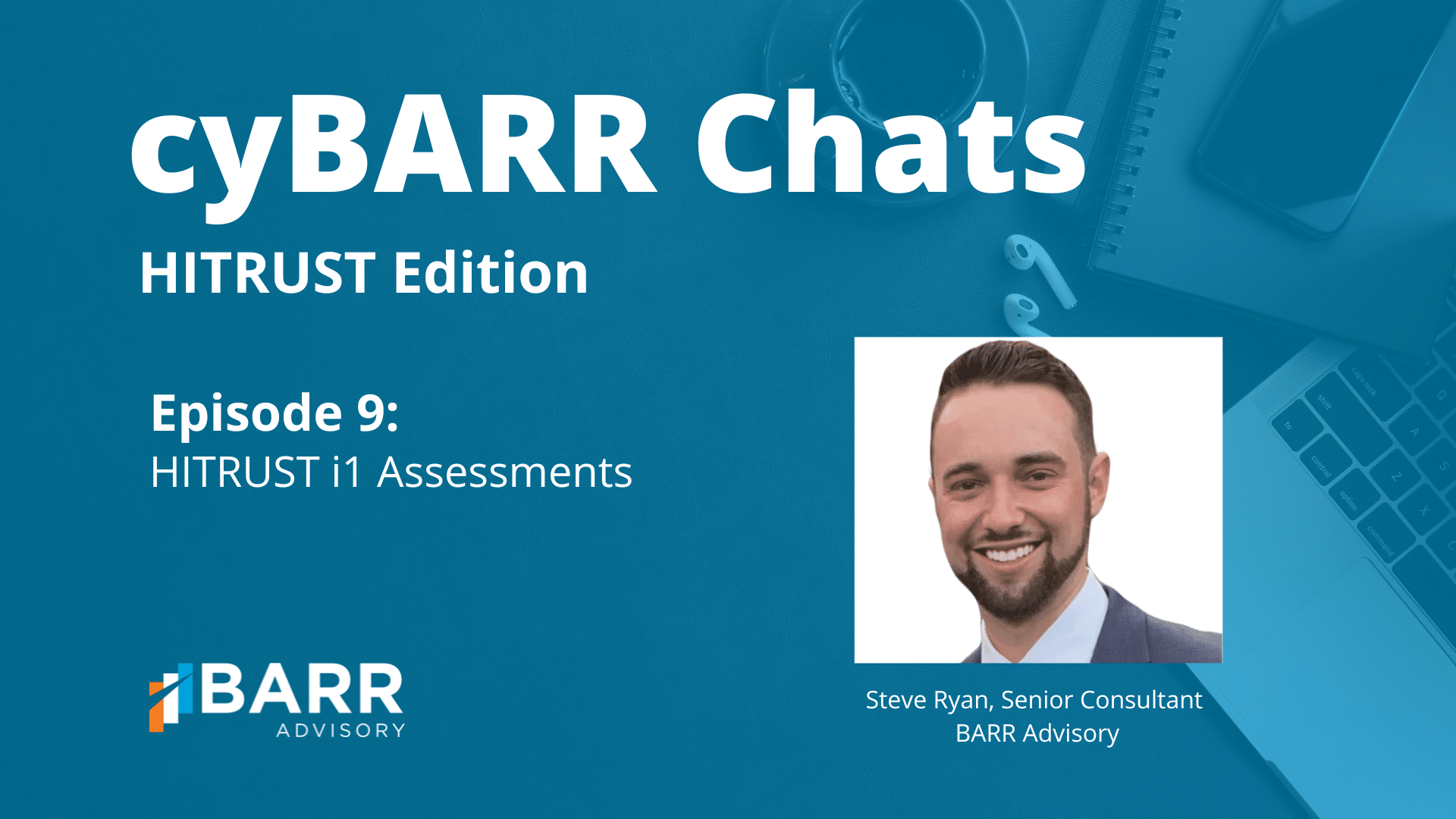cyBARR Chats, HITRUST Edition Episode 9: HITRUST i1 Assessments
LISTEN:

WATCH:
Transcript:
[00:00:00] Claire McKenna: Hello everyone. And welcome to today’s cyBARR Chat HITRUST edition. Today we’re joined by senior HITRUST consultant, Steve Ryan, to discuss new enhancements to the HITRUST MyCSF tool that were announced as part of their latest advisory. These new enhancements will be automatically implemented for all r2 validated assessments and r2 readiness assessments by October 1st.
So let’s learn what they mean for your HITRUST assessment. So Steve, just getting started. Why does HITRUST roll out new enhancements and how do these enhancements affect organizations that are going through the HITRUST process?
[00:00:39] Steve Ryan: Absolutely Claire. So HITRUSTee is continuously working to improve the user experience within that MyCSF tool to really ensure that both assessors and our clients are able to go through that HITRUST certification process as efficiency and with as much transparency as possible HITRUST has certainly come a long way within that tool.
The newly fun, the newly introduced functionality allows us to better serve our clients and for our clients to have a more clear picture of where they stand within that certification process. These enhancements will affect organizations going through the HITRUST process by improving their experience.
Now, there certainly may be some headaches trying to adapt to these new changes cuz as we know, not everybody likes change, but that’s why we’re here. We stay on top of these changes to ensure we get ahead of any potential headaches or issues with new interfaces.
[00:01:30] Claire McKenna: Great. And do these enhancements affect organizations that already have a HITRUST certification?
[00:01:38] Steve Ryan: Great question Claire. So for organizations that are already have that certification, these enhancements won’t necessarily affect them until they go through their next validation. It is imperative that these organizations work with their external assessors to stay on top of these changes to again, make sure there are no headaches or unexpected delays that could occur as a result of these enhancements.
[00:01:58] Claire McKenna: Okay, got it. So let’s discuss the first enhancement on the list with new assessment workflows, can you walk us through that enhancement?
[00:02:07] Steve Ryan: Of course. So this enhancement really adds an incredible level of transparency into that HITRUST process. So the new assessment workflow for HITRUST CSF validated assessments is really comprised of 16 workflow phases.
These workflow phases certainly have been there before, but they’re now more granularly defined to increase the transparency regarding assessment status and the remaining items needed to reach that next phase. Um, these phases do not add any steps to the current process, but like clarify the steps and who should be doing what for each step there.
The phases detail each phase such as answering the pre-assessment performing the validation all the way through accessing the final report there. And really that HITRUST website includes a great table that outlines each phase, a description of the phase. And some of those key changes that have occurred as a result of the new layout there.
[00:03:01] Claire McKenna: Awesome. That sounds like a great enhancement. Definitely. Always a good thing to get some more clarity. So what about the next enhancement? Um, with status dashboards?
[00:03:10] Steve Ryan: Absolutely. So again, this enhancement really provides a lot more transparency to the, MyCSF tool. Um, and it introduces several status dashboards outlining assessment, statuses, open action items and their ownerships, and the next steps in the assessment workflow.
Um, these dashboards are presented in a few different ways here. So first you had a con. , which is basically a big picture of where all of your assessment stand, what phase they’re in, and you’re able to kind of move them around as needed there. The next is a matrix view, which is more of a spreadsheet style view that displays the data of the HITRUST validated assessment.
Um, what or what date that has entered each phase, as well as the number of days the assessment has been in that phase. There. Then finally you have the assessment details view, which is really just a dashboard of assessment, metadata and status information, including some key dates, open items, and the assessment scope there.
And the dashboards are certainly more targeted towards us, the external assessors, but can provide the incredibly beneficial to large organizations who are mul are who are trying to really manage more than one validation at a time.
[00:04:20] Claire McKenna: Got it. Yeah. That makes a lot of sense. Um, my last question for you is, you know, in our last chat we discussed I one assessments.
Um, so do these enhancements affect those with an I one assessment or maybe that are thinking about getting an I one assessment?
[00:04:36] Steve Ryan: Yeah, definitely. Again, great question there. So those, I wanna assessments incorporate these enhancements by. So these I, one assessments will not need to be converted. And it’s kind of like above where if you already have an I one assessment nothing needs to be done.
It’s really focused on that next iteration.
[00:04:52] Claire McKenna: Got it. Well, that was my last question for this chat. So Steve, thank you so much for all of your valuable insight to some of the new enhancements, to the HITRUST, MyCSF tool and to our audience, you’ll want to stay tuned for part two of our conversation coming soon, discussing three more enhancements that are part of this advisory.
[00:05:12] Steve Ryan: Awesome. Thank you, Claire.